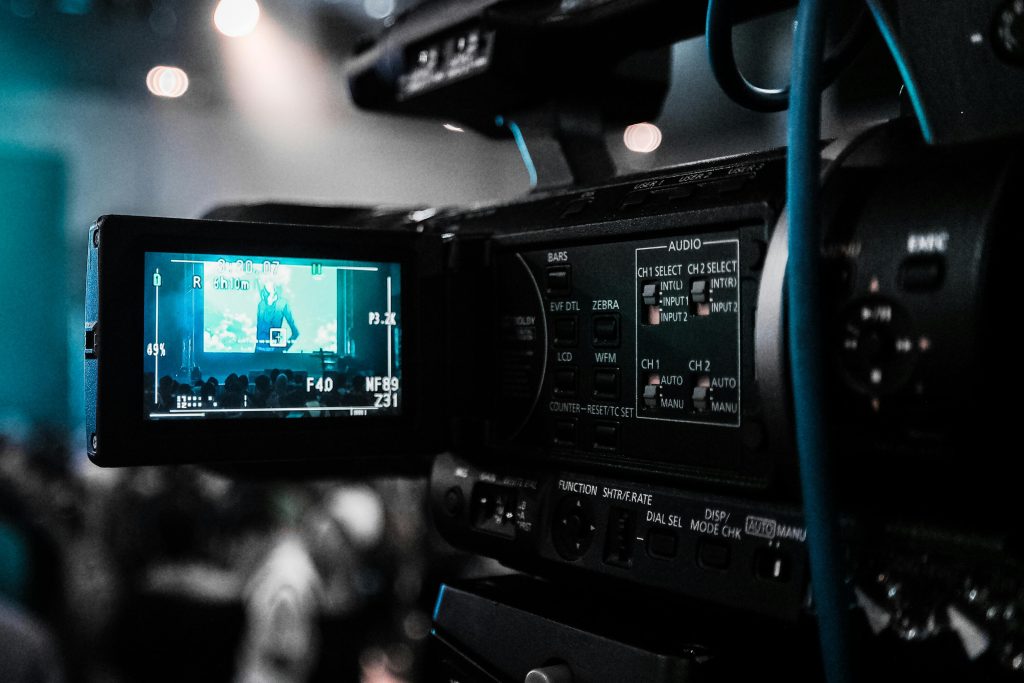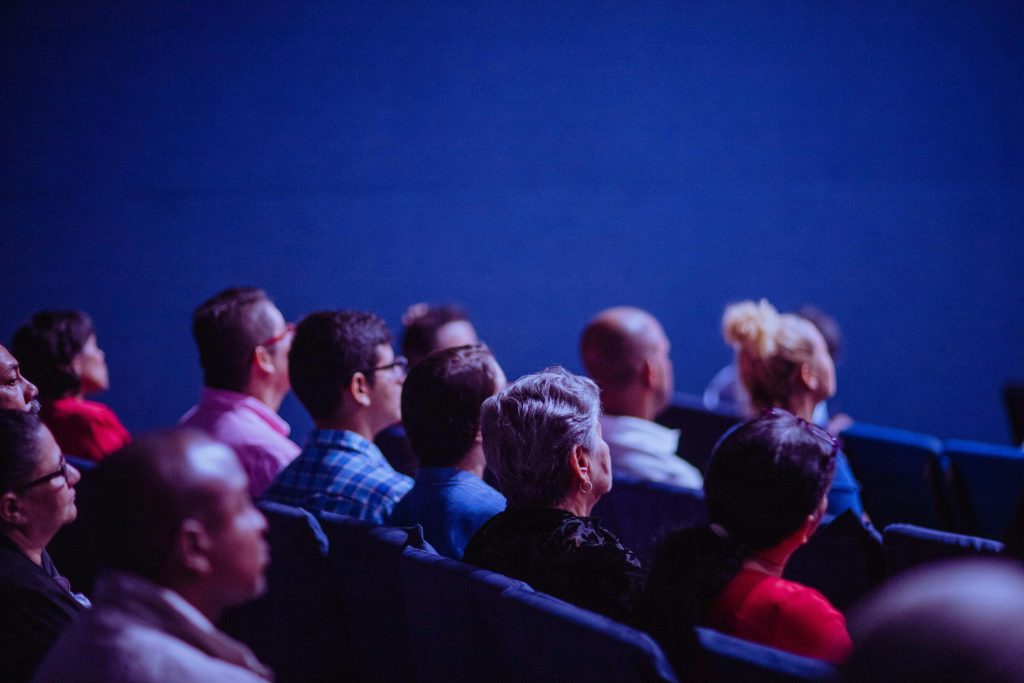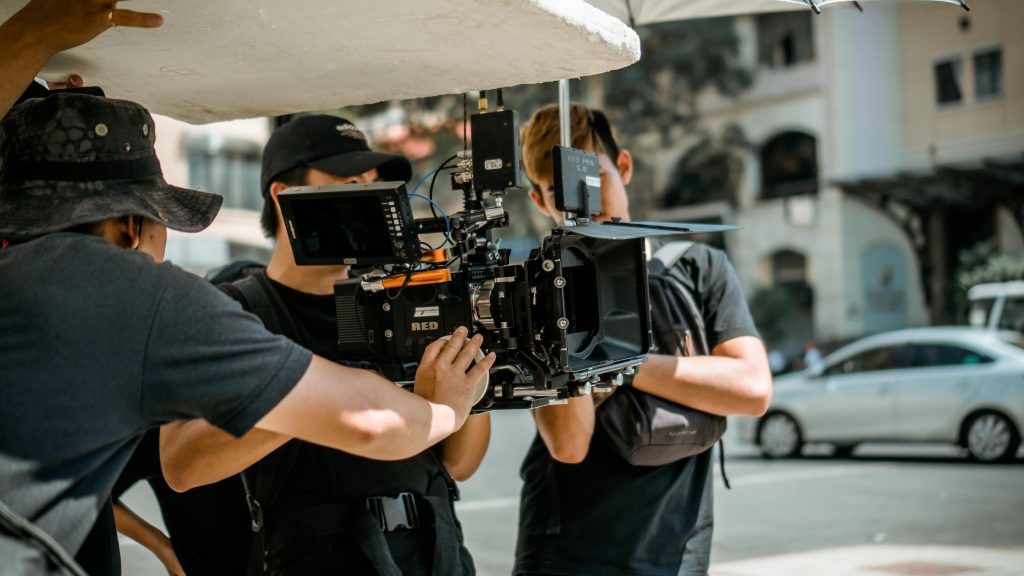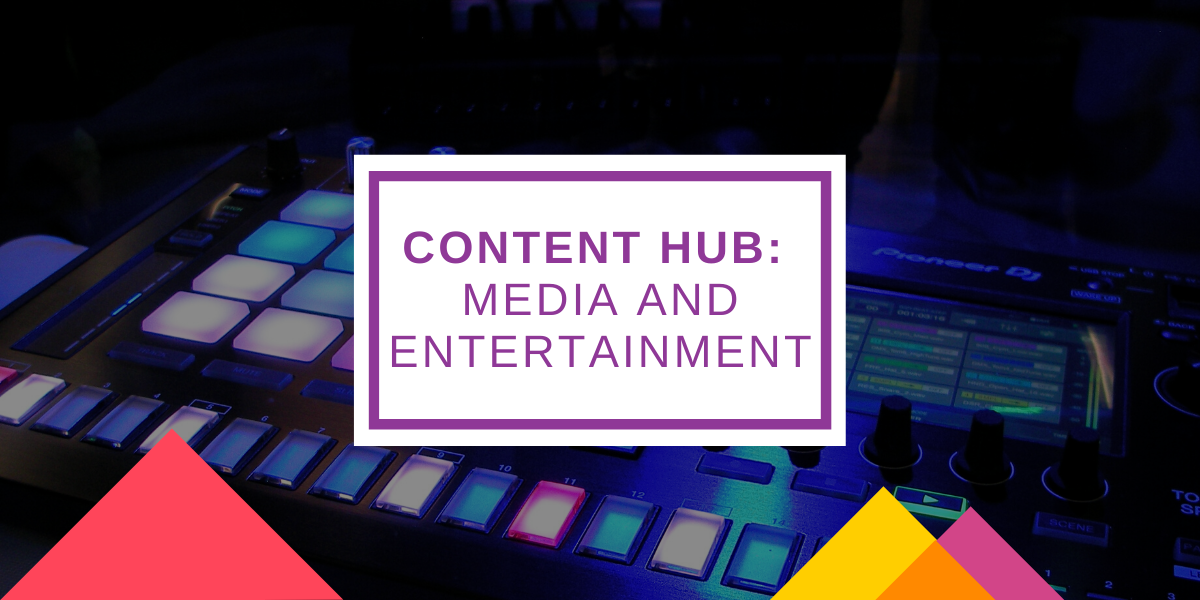The media and entertainment industry (M&E) has always been a fast-moving one, but never has this been the case more than right now. The industry is going through a period of exciting change, with new technologies driving innovation and growth opportunities. However, this also presents plenty of challenges, particularly from a PR perspective. That’s why we’ve put together this 101 guide full of advice and insight into media and entertainment PR.
- Anbieter von AV-Technologie: Haben Sie in letzter Zeit Ihre Marktpositionierung überdacht?
- How to make the most of your IBC 2024 show comms
- How to get ahead for IBC2024
- How to engage your audience in the themed entertainment space
- A change is as good as a rest: embracing the new media and entertainment landscape
- It takes two: five steps to amplifying your M&E brand partnership
Anbieter von AV-Technologie: Haben Sie in letzter Zeit Ihre Marktpositionierung überdacht?
In den letzten Jahren sind audiovisuelle Technologien zugänglicher geworden und haben eine größere Verbreitung gefunden als je zuvor.
Professionelle Kameras, Produktions-Workflows und Back-End-Technologien sind nicht mehr nur den Fernsehsendern vorbehalten; viele große Marken nutzen diese Technologien inzwischen intern, um Content und Videomaterial für das Marketing zu erstellen. Projektoren, HD-Bildschirme und Displays werden nicht nur in Unterhaltungseinrichtungen eingesetzt, sondern auch in Einzelhandelsgeschäften, Freizeitparks und an anderen Orten, an denen standortbasiertes Entertainment (LBE) angeboten wird. 3D-Modellierung sowie AR- und VR-Pipelines werden natürlich nicht nur in der Architektur und im Produktdesign eingesetzt, sondern auch in den Bereichen Visual Effects (VFX) und Postproduktion.
Obwohl dies bereits seit einigen Jahren der Fall ist (und auch weiterhin sein wird), kommt es immer noch häufig vor, dass die Anbieter dieser Technologien an ihrer alten Marktposition festhalten und ihr Messaging nicht an die neuen Zielgruppen anpassen. Das ist bedauerlich für Marketing- und Vertriebsteams, die gezwungen sind, Content oder Materialien zu verwenden, die für den professionellen Medienproduktions- oder -vertriebsmarkt konzipiert wurden und nicht für ihre eigentliche Käuferbasis.
Als Agentur für integriertes Marketing sprechen wir mit unseren Kunden oft über dieses Thema. Daher habe ich mir gedacht, ich gebe Ihnen einen kurzen Überblick darüber, wie Sie Ihre Marktposition verbessern können.
Zeigen Sie, dass Sie ihren Markt kennen
Bei B2B-Verkäufen legen Käufer großen Wert darauf, sich an einen Verkäufer oder Dienstleister zu wenden, dem sie vertrauen können. Auch wenn der B2B-Verkaufsprozess in den letzten Jahren nicht in gleichem Maße gestört wurde wie der Verbraucherverkaufsprozess, ist die Kaufkraft immer noch von Generationen geprägt, die erwarten, dass sie den Verkäufern, mit denen sie Geschäfte machen, vertrauen können.
Wenn Sie nicht nachweisen können, dass Sie den Markt Ihrer Kunden kennen, wird es unweigerlich schwieriger, Ihnen zu vertrauen. Indem Sie sich auf jedem Markt, auf dem Sie verkaufen wollen, anders positionieren, können Sie zeigen, dass Sie sich für die spezifischen Bedürfnisse dieser Menschen interessieren, anstatt einfach nur verkaufen zu wollen.

Erkennen Sie die unterschiedlichen Herausforderungen Ihrer Kunden
Die Herausforderungen, auf die Ihre Technologie oder Ihre Dienstleistungen reagieren, sind nicht immer von einem Sektor auf einen anderen übertragbar. Daher ist es wichtig, dass Sie einen Aktionsplan erstellen und Ihre Positionierung an die Bedürfnisse der verschiedenen Zielmärkte anpassen. Andernfalls laufen Sie Gefahr, die falschen Verkaufsargumente in den Vordergrund zu stellen und potenzielle Kunden nicht anzusprechen.
Im Rundfunkbereich werden beispielsweise die Geschwindigkeit und Effizienz Ihrer Technologie die wichtigsten Verkaufsargumente sein. Wenn die gleiche Technologie jedoch bereits von großen Marken verwendet wird, ist es wahrscheinlich, dass Ihre Zielgruppe nach einer benutzerfreundlicheren Schnittstelle sucht, die die Ausbildung von Personen ohne Medienerfahrung erleichtert.
Passen Sie Ihre Sprache an
Nachdem Sie die dringendsten Herausforderungen identifiziert haben, bei denen Ihre Technologie Ihren potenziellen Kunden helfen kann, besteht der nächste Schritt darin, diese Herausforderungen auf die richtige Art und Weise anzusprechen.
Die Sprache, in der Technologien, Dienstleistungen und USPs (Unique Selling Points) beschrieben werden, ist ein weiteres unterschätztes Element bei der Positionierung von Anbietern auf dem Markt. Wenn Sie an einem Tag an einen Veranstaltungsort und am nächsten Tag an ein Medienstudio verkaufen, werden bestimmte Begriffe und Ausdrücke einfach nicht vom einen auf den anderen übertragen. Um sicherzustellen, dass Ihre Verkaufsbotschaft bei jedem Zielpublikum ankommt, ist es wichtig, dass Ihre Materialien zur Verkaufspositionierung diese wichtigen Unterschiede beschreiben. Auf diese Weise ist Ihr Verkaufsteam gerüstet und bereit, potenzielle Kunden mit dem anzusprechen, was sie brauchen, um in den Markt einzutreten.
Was können wir daraus lernen?
Auch wenn der Aufbau einer neuen Marktposition vielleicht nicht zu Ihren obersten Prioritäten gehört, wird diese einfache Änderung mit Sicherheit eine große Wirkung haben. Sie wird sich schnell auszahlen, da sie Ihr Team in die richtige Richtung für seine Markteinführungspläne lenkt.
Vielleicht sind Sie in einen Markt eingetreten, haben aber nicht die gewünschten Ergebnisse erzielt, oder Sie sehen Chancen in neuen Geschäftsfeldern? in beiden Fällen ist es entscheidend, richtig positioniert zu sein. Genau das tun unsere Teams Tag für Tag, indem sie unseren Kunden dabei helfen, die Märkte zu analysieren, auf denen sie Kunden gewinnen wollen, und indem sie ihnen dabei helfen, ihre Geschichte auf die richtige Weise zu erzählen.
Im Klartext: Wenn Sie jetzt nicht handeln, riskieren Sie Umsatzeinbußen. Achten Sie darauf, nicht den vollen Preis zu zahlen.
Sind Sie bereit, Ihre Marktkommunikation zu erneuern? Lassen Sie uns darüber sprechen.
How to make the most of your IBC 2024 show comms
When it comes to IBC, what happens in Amsterdam most certainly doesn’t stay there. Our head of mediatech, Martin Izzard, is here to share some tips for communicating purposefully and maximising your impact at the show.
As marketers, the run-up to a major trade show like IBC can be hectic. From managing stand design and marketing collateral to sponsorship activities and events, there’s a seemingly never-ending list of things to do…
In the melee of deadlines and decisions, it’s easy for comms to take a back seat. That is until – right before the show starts – someone asks whether you’ve set up some meetings with journalists or entered an award (shoulda, woulda, coulda, right?).
With that in mind, we wanted to share some tips to help. After all, you’ve already shelled out thousands for your stand, travel and new business activities at the show, so why not go the extra mile to maximise your comms impact?
Use trade and industry publications
In media technology, we’re lucky that trade publications are still widely read and respected. This means they can have a real impact on your brand awareness. But this isn’t something to take for granted. With journalists spread increasingly thin, you need to take the time to engage with the media and tell your story.
As well as news and editorial ideas, we advise all our partners and clients to include at least some advertising or sponsorship spend in their exhibition budget. Ultimately, we need to support the publications we value to ensure the media landscape continues to thrive.
Third-party endorsement
Particularly at trade shows, comms can become a bit of a chest-beating exercise – whether that’s in how you speak about products or profile the people in your organisation.
However, the greatest impact doesn’t come from how often (or how loudly) you talk about yourself, but from third-party endorsement. The best way to get this at a show like IBC is by involving your customers, whether through a partnership announcement, joint media briefings, case study presentations, or even co-branded social media content.
Remember, customers and partners are valuable influencers for your business.

Don’t sell products – tell a story
It’s easy to think of a trade show like IBC as somewhere to showcase products in the hope the right prospect comes along. But with halls full of other exhibitors, you may find yourself getting lost in a sea of other solutions on display.
You’ll be pleased to know that the answer isn’t simply to invest in a bigger and brighter stand. Instead, a great way to stand out is by crafting a story that resonates with prospects. One that uses emotion (and even a dose of humour) to demonstrate that you understand their problems or to inspire them to think bigger and bolder.
We always tell clients that new product announcements and solution displays shouldn’t be about the buttons and the switches, but the benefits. By telling a story, you can better explain how your products help customers and improve their day-to-day operations and bottom line.
Another top tip: when crafting your ‘story’, it can be tempting to throw the kitchen sink at it. But simplicity and consistency are key to cutting through the noise (read: most of the time, no one wants to hear about your founding in 1991 and every company milestone since then). Your story should be your theme for the show and visible in everything, from your stand design to how your salespeople speak to visitors.
Get show ready
So far, so good. But how on earth are you going to get this all done before September? Maybe we can take something off your plate. The mediatech team at the lorries understands IBC inside out. We know who you’ll want to meet with, how to look after social media at the show, and how best to share news and customer stories.
So, if this is something we can help you with, get in touch. We have some specific show comms packages to make it quick and easy to maximise your presence at IBC.
See you in Amsterdam.
How to get ahead for IBC2024
During our time attending IBC, the leading broadcast media technology show in Europe, we’ve learned a thing or two. While the broadcast media industry has evolved, so has the landscape for PR and comms. It’s no longer about just trying to make a huge splash with demos on the show floor. You need to support your physical show comms by finding the right platform with which you can connect with your prospects and potential customers.
Because we’ve got this well of knowledge, we wanted to share a few tips that will help you get ahead for IBC2024.
What’s your story?
Ahead of the show, don’t think of your trade show presence simply as a series of demos. Decide what element of your brand story you’re trying to tell. Think about how you want to position your products to the potential customers that might be walking by.
Outlining what your story is for a show like IBC can be really effective. It should be visible in your signage and press communications, be a part of how you speak about your company in sales meetings or as part of your social media activity around the show.
And make sure to brief what that positioning is to your teams so they can integrate it into their conversations with customers for joined-up and thought-out show comms.
Don’t just do it because you always have
‘If it ain’t broke don’t fix it’ is the worst approach you can have in any communications. This is especially true for a trade show which is always a big investment, regardless of how you approach it.
And what the last few years have shown us is that trade shows have needed to evolve to address an industry that’s experienced many changes since pre-2020. Whether it’s speaking to people who have a bigger focus on remote working and managing a distributed workforce or integrating more digital platforms into your comms, the Einstein adage of the definition of insanity has never been more true than it is in 2024.
Think objectively about what you’re planning on doing. And don’t just plan in activity because it’s always been the way you’ve done things. Because you might be missing something key that’s going to have a huge impact.

Think about what will deliver the most value
This last point is somewhat linked to all of the other tips we’ve shared above. And it’s all about value. As an agency, our primary goal is to provide value to our clients and our partners. We should be delivering results for them that are actually impacting the business.
And the same needs to be said for all your show plans. If the activity you were planning on doing isn’t a value-add then you ask if it’s really necessary. And if it isn’t, then is that what you need to be spending your time on?
And stick to it
When you’ve made those decisions, it’s really easy to be drawn back to doing something because someone has spotted that a competitor is doing something else. But if you’ve made your plans on sound logic; stick to your guns.
Your story, your press activity and your value-add activity is what will deliver a successful comms campaign around a show like IBC2024.
If you’re exhibiting at the show and you need support with any or all of the above, give us a call. In our 20 years at the show, not only do we know our way around the show itself but also around the opportunities available to exhibitors.
The lorries can help you define your story, build out a plan of activity, set up meetings with key industry journalists and support you on the show floor.
Just get in touch, we’d love to talk to you about how we can help.
How to engage your audience in the themed entertainment space
Media and entertainment stretches much further than the movies you go to see at the cinema, or the shows you watch from your sofaplex. Over the last few years, immersive/themed entertainment has become more and more popular – from the latest attractions at the biggest theme parks, to independently-run immersive theatres and everything in between.
The technology behind these entertainment experiences is always interesting to the entertainment junkies here at the lorries. Not only do they have to walk the line between innovation and creativity, but most importantly, they need to go completely unseen in order to maintain a themed location’s illusion or facade.
Unfortunately, that invisibility to guests isn’t necessarily conducive to the marketers and communications teams charged with telling the story of their technologies. So while the world continues to open up again after a year or more of public spaces being shut down, the media and entertainment team here at the lorries wanted to provide a bit of insight into how technology providers to the themed entertainment space can bolster their communications and tell their stories in the most effective way possible.
In our new eBook – Location-based communications – we outline the challenges that many technology-focused marketers within the themed entertainment industry commonly come up against and what you can do to overcome them. We even borrow a little vernacular from Walt Disney himself, and give you some free advice on how to plus your communications, including:
- The main challenges facing marketers
- What you need to succeed
- How you can stand out from the crowd
If you’re a technology provider working in the themed entertainment industry and think our expertise in telling the stories of a number of industry-leading entertainment technologists could help you reach a wider audience, get in touch now.
We’d love to hear from you. We could even meet at Thorpe Park if you want? We’ll get the tickets.
A change is as good as a rest: embracing the new media and entertainment landscape
The lorries have been working in the media and entertainment (M&E) space for nearly 20 years. But the industry and the way we define it, isn’t what it was 10 years ago.
“Media” used to be the TV broadcasts that we watched in the living room and the films we watched at the cinema. Now it includes programming of any and all lengths, watched on any device that has a screen. Branded YouTube channels and social accounts are driven by media that’s as professionally produced as many TV shows or films.
On top of this, we have more cinematic and immersive games than ever, media-driven marketing campaigns, incredible outdoor displays, location-based entertainment, VR activations, digital displays and theme park attractions. These all require media that must be created, managed and delivered in the most efficient ways possible.
Media has become so all-encompassing, and audiences and consumers now expect to be entertained on an almost minute-to-minute basis. As a result, platforms that didn’t previously exist or that have completely changed over the last few years through the augmentation of technology, are now some of the most important.
Media is now acting as a bridge between brands, marketing professionals, technologists and consumers. And there’s more pressure on technology vendors to tell a story that connects with both the CTO and the CMO.
Revenue streams have changed – shrunk in some areas, and expanded in others. This means the M&E technology providers that once worked solely with broadcasters and filmmaking creatives are now partnering with a huge number of organisations in a wider range of industry verticals – all with different challenges and levels of knowledge
For an agency like Red Lorry Yellow Lorry – one with a speciality in ‘media and entertainment’ – this means two things. Firstly, we’re working with existing M&E clients and organisations to help them adapt by addressing new markets, audience expectations and revenue streams. And secondly, we’re providing our range of services across the marketing and communications mix to new technology and service providers operating within this space – using our industry knowledge and expertise to help them gain some traction in this ever-changing and increasingly competitive landscape.
So, as I take on my new role of Head of Media and Entertainment in our London office, it’s clear to me that this is going to be a really fun challenge. I’m looking forward to engaging with technology providers who are innovating with the creation, management and delivery of media that entertains, no matter what form that takes.
Here’s to the new M&E landscape!
It takes two: five steps to amplifying your M&E brand partnership
When you join forces with another business to collaborate on a project or create a new product, service or initiative, you want to shout about it. Until now, business was great. But with your new brand partnership, you’re set to be propelled into the fast lane.
Together, you’re driving something epic (maybe you’ve managed to upgrade from a Nissan Micra to a Ferrari). And whether it has already hit the road or is waiting patiently to make its debut, people should know about it.
Your brand partnership is a result of great chemistry, complementary technology and a shared goal. As the saying goes, it takes two to tango. Or in the case of the b2b media and entertainment industry, it can take more than two. While M&E businesses aren’t exactly known for strutting around the dancefloor, they shouldn’t be shy of putting on a show when it comes to amplifying their brand partnerships. After all, there’s an audience there waiting to be entertained.
The hesitations that hang over M&E marketers when looking to promote brand partnerships tend to influence whether they get promoted at all. Yes, the coordination between all parties can be testing, especially when factoring in what works best for everyone and some of the potentially big names involved. But the pay-off is worth it. So, how can you make the process easier? How can you make the most of your brand partnership? And how do you do the tango in time with the beat and without stumbling over each other’s feet?
-
Set the T’s & C’s
Ugh, the dreaded terms and conditions. The ten-page document. The small print. The misinformation! There’s no need to go into this much detail, but do take the time to agree what PR activity you’re willing to collaborate on as soon as you can. Raise this earlier on in your partnership, so you can plan ahead and strike while the iron’s hot.
An efficient way to set the T&C’s is to create a one-page checklist of PR items. Brands can simply tick which activity they’re able to participate in, including awards, speaking opportunities, blogs and press releases. Not only does this save time later down the line, but it also sets the tone of your partnership – locking down messaging and their level of involvement from the get-go.
-
Make a good first impression
I know you’ve heard it before but I’m going to echo it here again: first impressions count. That’s never been truer in the world of PR where more brands are under the media and public’s microscope than ever before. With one shot at announcing your brand partnership, there’s several things to consider if you want to avoid slipping up.
Timing is key. If there’s a trade show going on where journalists will rally in numbers, you either want to avoid this time completely or use it to your advantage. For example, if you’re not exhibiting at or attending the show, it’s not worth getting caught up in the noise. With press unable to visit your booth or meet you in person, there’s no incentive for them to give your announcement any attention. As businesses and attendees know, trade shows give people tunnel vision where nothing outside of those four conference centre walls matters. But if you are going to be there, make the announcement in conjunction with the show. This can be done by:
- Sending a press release on the partnership to key media targets under embargo before the show starts, stating when the embargo will be lifted and offering exclusive interviews with the relevant high-profile spokespeople. While these interviews can take place at the show, it’s also worth putting time aside to hold interviews over the phone or face-to-face before the show takes place. Journalists often like this as it gives them breathing space beyond the stuffy conference halls and an advantage against competing publications. And we like this because it encourages higher quality coverage, builds brand awareness and facilitates media relationships.
- Holding a press event in a conference space or at your booth in addition to formalising the announcement through a press release. A press event gathers the people who matter in one room in order to generate hype around your announcement. It allows you to directly communicate with the journalists and entice their interest – even if it takes a few freebies to get them there. It also gives you some fodder to share on your social channels, including images and quotes.
While a press event can be held at a trade show, it’s not limited to them. Providing it doesn’t conflict with another event, you can hold a press conference in your office, an interesting venue or even over breakfast.
However, it’s not a valid option if the representatives from all participating brands aren’t able to attend. As well as increasing excitement, the aim of an event like this is to demonstrate your unification. Without the right spokespeople there, there’s nothing to exactly ‘unify’. If conducted with a high degree of organisation and planning, a press event can maximise your announcement beyond the press release.
A question mark may hover over which partner will do the announcement. It’s best for it to come from the company which is likely to make the biggest impact. For example, if you’re a start-up joining forces with a much larger, renowned company, it’s more effective for the latter to make the announcement due to their reputation and industry platform. This will help secure more coverage by extending the announcement beyond the smaller company’s immediate network.
To really create a lasting first impression, consider making your announcement more visual. This can be achieved through various types of multimedia, which can instantly give the announcement a facelift. Effective methods include filming a short video with key executives to explain the partnership, creating a hero image of the logos merged together, and building an infographic which illustrates what the partnership is addressing and how it can benefit customers.
-
Build momentum
It’s easy to give your announcement a short life by sticking with a press release and moving on. Done and dusted. But there are a lot of opportunities to continue the story by refreshing the news and talking about it in more depth.
One way this can be done is by holding an intimate press dinner or breakfast to demonstrate your unification and delve deeper into the formation of your partnership. Speaking to a select group of press, as well as opening the opportunity to talk to them one-on-one, builds the brand’s profile as well as the spokespeople. With this in mind, it’s essential to keep the door open for interviews once the news of the partnership is out there. Even if the journalist has already covered the story, there may be another dimension to the news in the future. Don’t shut the door too soon.
-
Collaborate, after all
Collaboration. Isn’t it obvious since it’s the premise of what we’re talking about here? Well, not exactly. Defining collaboration beyond your partnership is often difficult. It makes people wonder what’s worth the time and effort and who exactly will benefit from what. This is why setting the T&C’s is important. Once you reach this stage in promoting your partnership, you should’ve both laid out what you expect from each other. And ta-dah! You can get the ball rolling.
Depending on what was agreed, you can explore collaborating on content for each other’s websites – whether that be written, video or even podcasts – to raise brand awareness and shine the spotlight on your thought leadership expertise. Each party can then share this content within their own marketing to spread the word further, such as newsletters, social media and lead generation. You can even consider doing a PPC campaign to get this content in front of new prospects in their thousands.
Another collaboration opportunity could be to conduct a piece of research. Once you’ve found a research topic that’s relevant to both your customer bases, launch a research project to provide them with valuable insight and data. Not only does it highlight the strength of your partnership in continuing to deliver resources which matter, it will also give you lots of collateral for further PR activity such as press releases, social media (including infographics), content (whitepapers, thought leadership articles) and lead generation (InMails).
-
Plan ahead
Never underestimate the power of planning ahead. Your efforts (and sanity) will thank you later. By estimating milestones in your partnership, you can foresee the other announcements that can be prepared for ahead of time, such as product updates and customer use cases.
Once you have customers and definitive results on what your partnership has achieved, investigate if there are any industry awards you can enter together. Many trade awards programs include categories that focus on collaborations and projects. This is something we saw success with for our client IBM Aspera and its collaboration with FOX Sports to deliver a revolutionary production workflow for the 2018 World Cup. We helped IBM Aspera secure two award wins – the highly coveted HPA Engineering Excellence Award (which honours outstanding technical and creative ingenuity in the professional media content industry) and the “project” category of the IABM BaM Awards (which recognises outstanding technological innovations that deliver real business and creative benefits).
So remember: set the terms and conditions up front, make a positive first impression with media, build momentum after the initial announcement, embrace collaboration with your partners and plan ahead. Follow these five steps and your next brand partnership will rule the dancefloor instead of falling flat on its face.
Do you need help amplifying your brand partnership? Drop us a line at hello@rlyl.com or visit our contact page.




